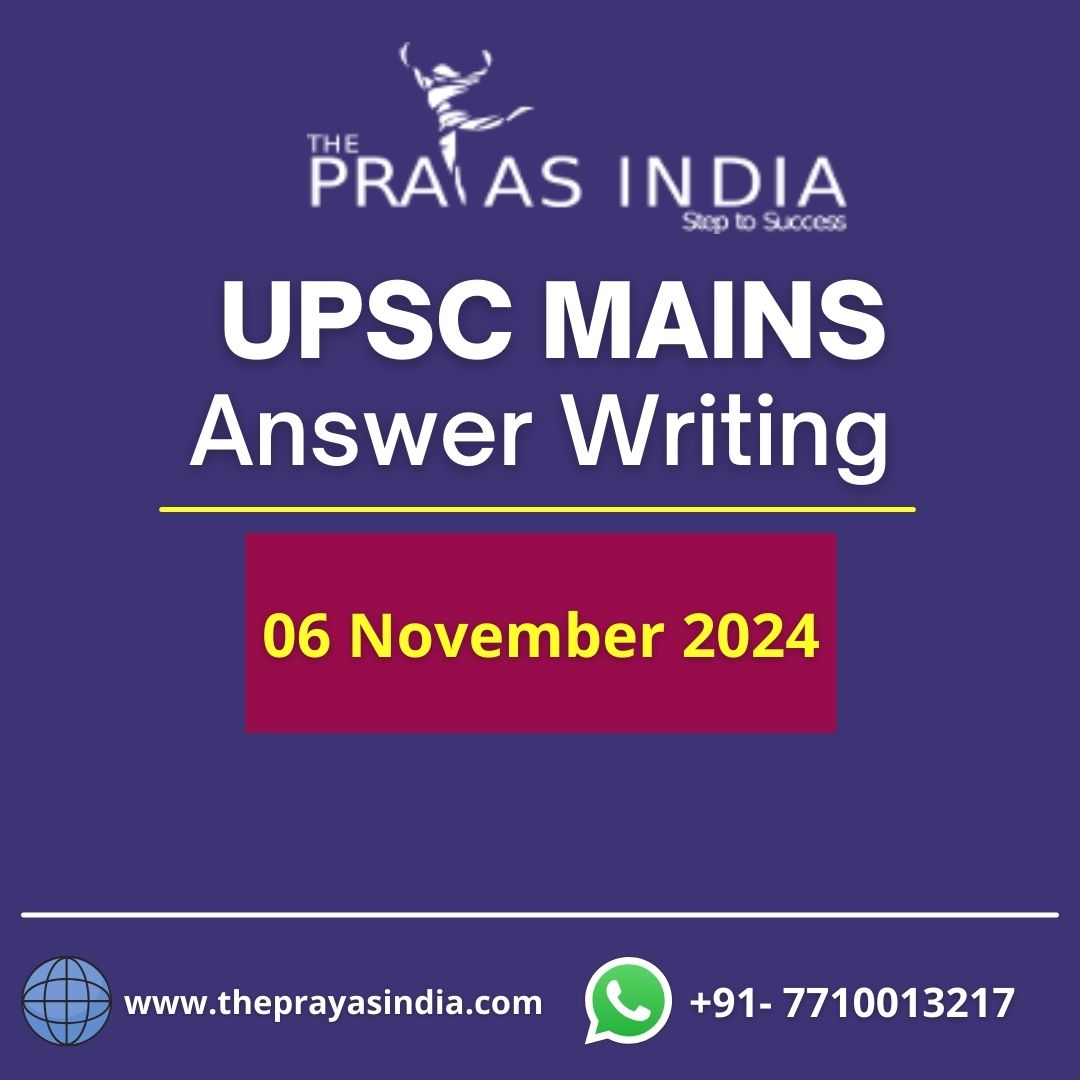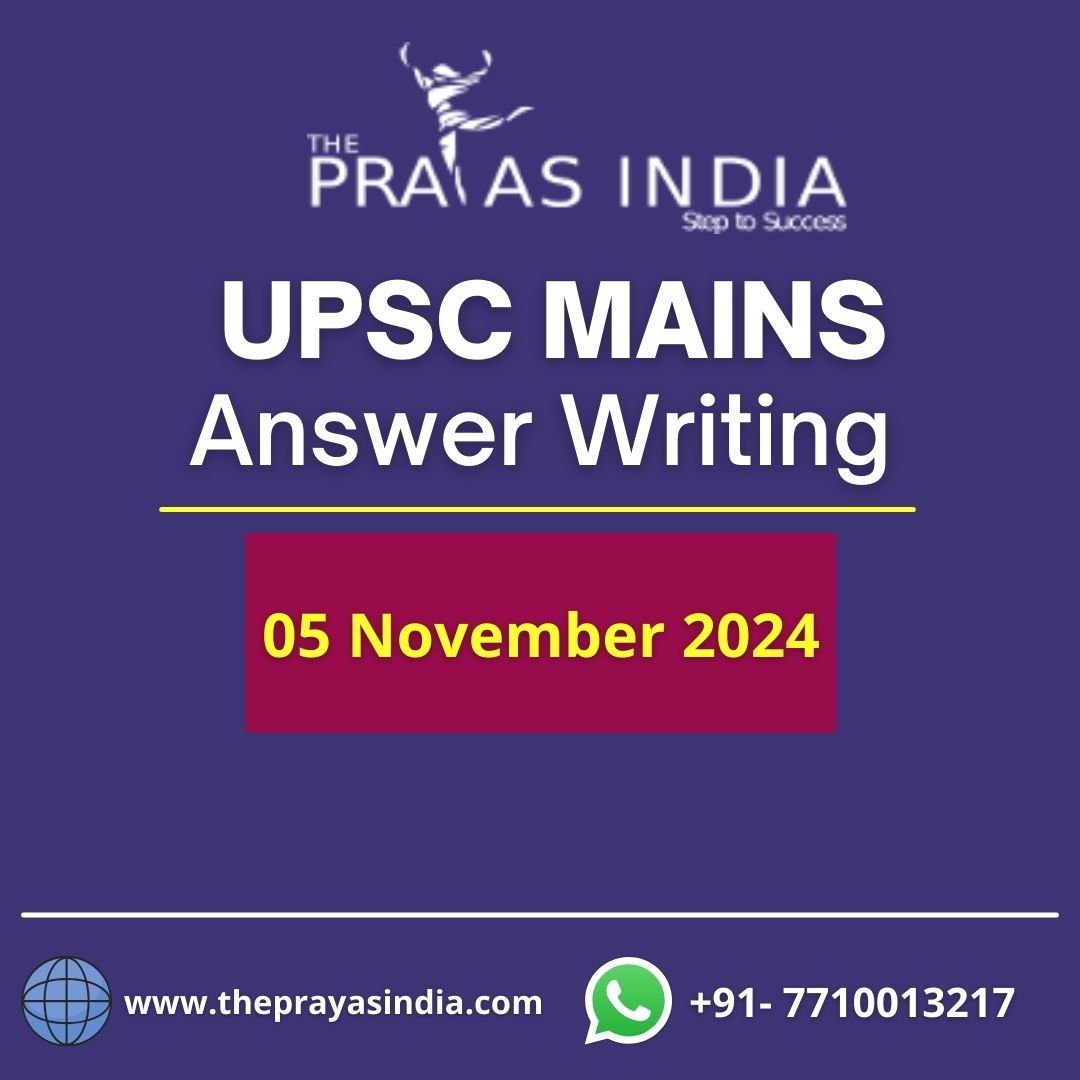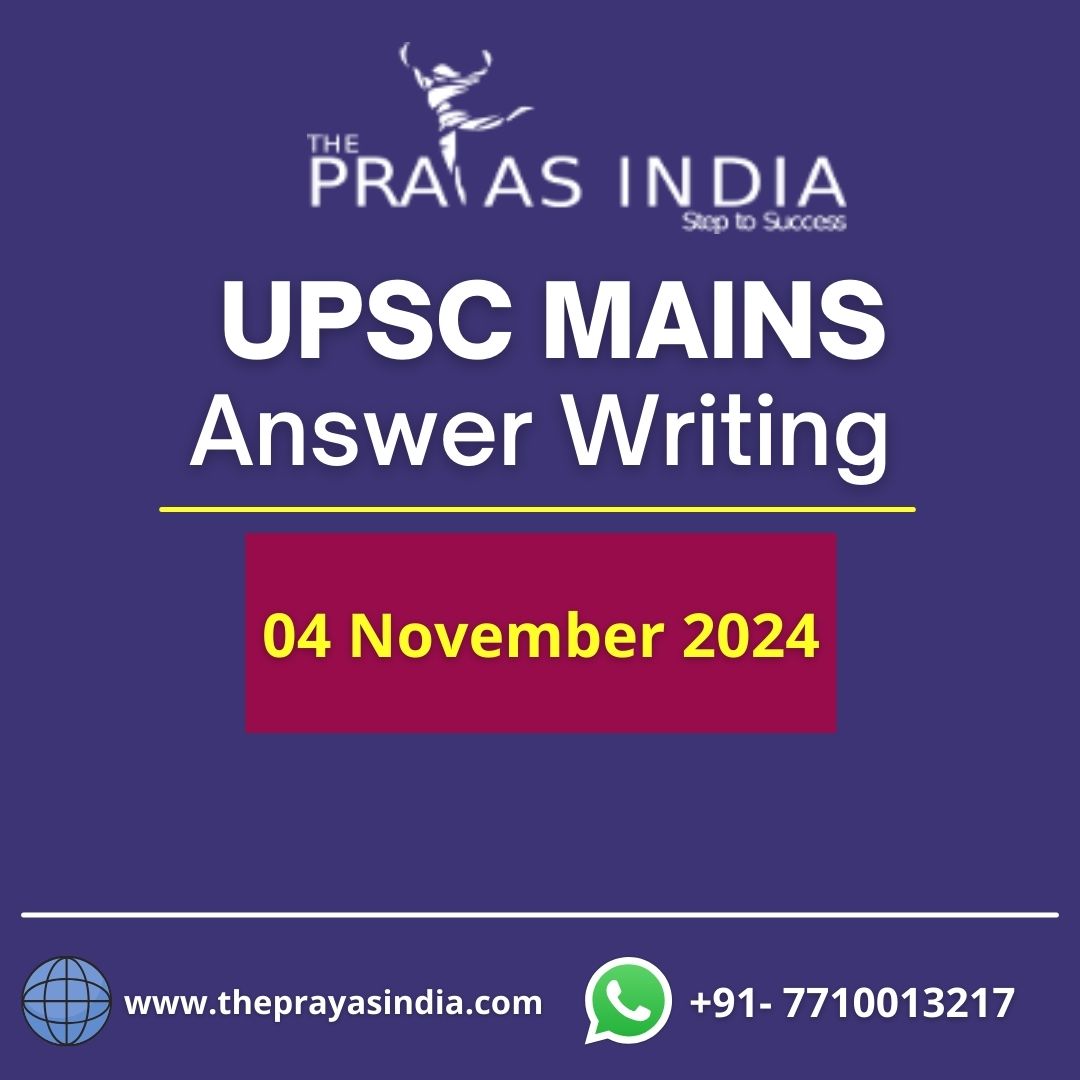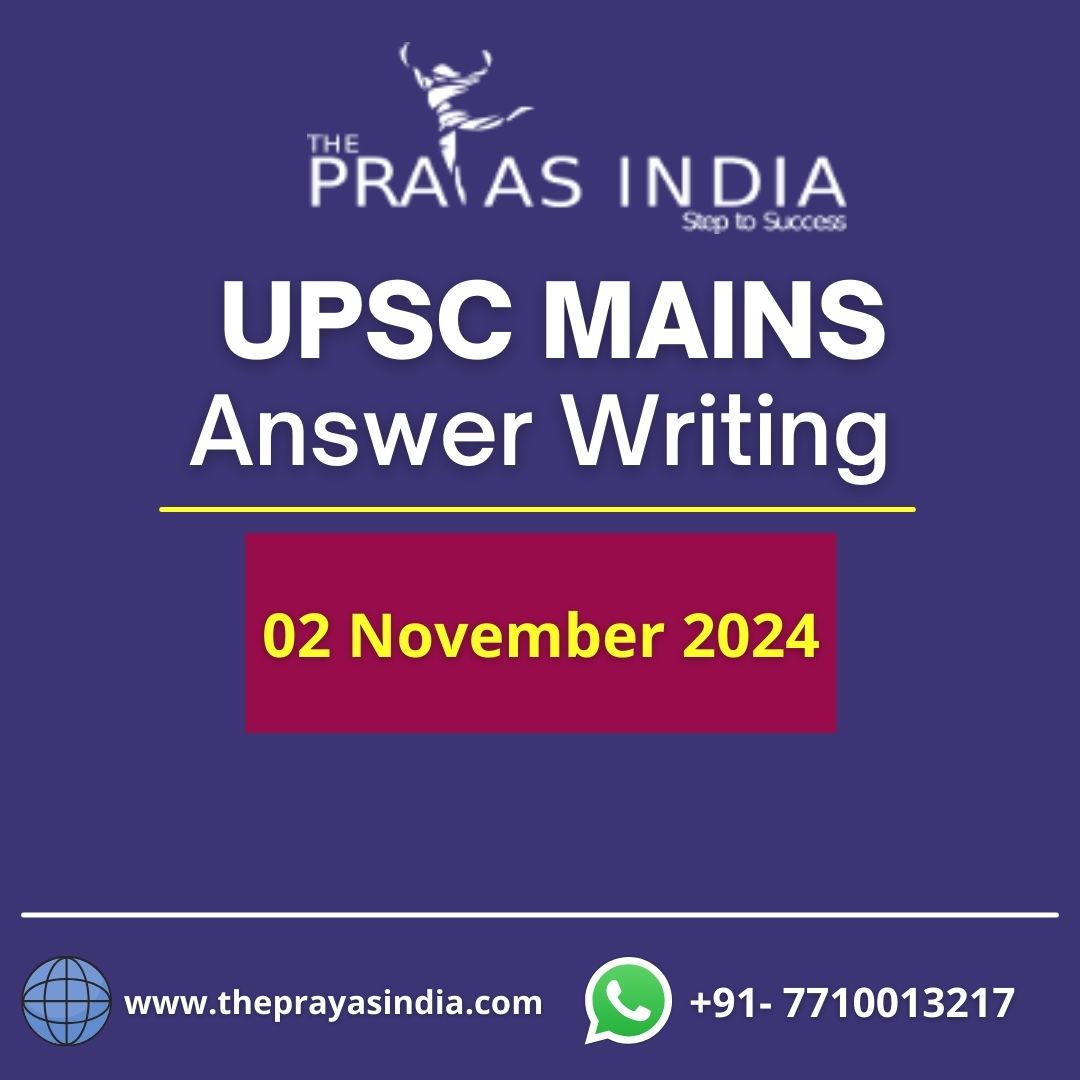DAILY QUESTIONS & MODEL ANSWERS
Q1. Take into account the economic significance of the resources on the continental shelf of the Indian Ocean. (250 words)
Paper & Topic: GS II – Physical Geography
Model Answer:
Introduction:
- A continental shelf is a large, typically shallow undersea terrace of continental crust that forms the edge of a continent. The majority of continental shelves have ridge and swale topography, which is characterised by a gently rolling landscape. Continental shelves usually have geology similar to the nearby exposed section of the continent. Continental shelves make up about 8% of the earth’s surface.
Body:
Resources in the continental shelf of the Indian Ocean are economically significant:
- Among the biotic resources are fish, crabs, mollusks, seaweed, and other edible marine life.
- Marine life produces leather, oil, fur, and cow feeds, among other things.
- Marine flora and animals are also used as medicines.
- The continental shelf seaweed is used in textiles and food.
- coupled with all biotic resources Fish are particularly important to the people of the Indian Ocean region since they are a great source of proteins and account for more than 10% of the meal with animal protein. Popular fish include, among others, tuna, mackerel, salman, sardine, and prawn.
- The fishing and aquaculture industries are a key source of exports. India’s maritime exports surged 55 times in volume between 1962 and 2012, and the country now exports fisheries worth Rs. 16,600 crore, or almost $2.5 billion.
Minerals Resources:
- The mineral resources recovered from the Indian Ocean continental shelf comprise both metallic and non-metallic minerals, either in dissolved form or as suspensions. One of the dissolved salts is table salt. such as bromine salts, magnesium salts, and sodium chloride.
- Among the minerals that are taken from the shelves are petroleum gas, magnesium, sulphur, iron, gold, silver, and polymetallic nodules of copper, zinc, and other metals. These are advantageous for commercial use.
- Oil and natural gas rank among the most valuable mineral resources. 90% of the value of sea mineral goods comes from them. Think about Bombay High.
- Put downs in Placers: For the safety of nuclear energy, the possibility of thorium reserves in the placer sands of the Malabar coast is essential.
Energy Sources:
- Tidal Waves: As the tides rise and fall, they release a lot of energy by crashing on the shore. A turbine can be turned by tidal waves to produce power. For instance, a Tidal Wave plant has been constructed in Durgaduani, West Bengal’s Sunderban.
- Surface and subsurface energy Different Water Temperatures: In tropical waters like the Indian Ocean, the sub-temperature is 5°C, while the surface temperature fluctuates from 25 to 30°C. This vertical temperature difference can be used to generate power. Consider the Tamil Nadu Ocean Thermal Energy Conversion Plant.
- On continental shelves, there are active volcanoes and fracture zones that can be used to harvest heat for geothermal energy.
Tourism:
- Coral atolls in the Lakshadweep, Andaman, and Nicobar Islands are popular with tourists from India and outside. This helps support the livelihoods of many islanders.
Conclusion:
- People place a high value on the Indian Ocean Continental Shelf economically. The Indian Ocean is a “ocean of economic opportunities” for India. The security dangers posed by State and non-State actors are impeding the advancement. Among other government initiatives, programmes like SAGAR, IORA, and Sagarmala should ensure that the advantages of the blue economy are fully realised.
Q2. Critically examine the need for and justification of India’s caste-based census. (250 words)
Paper & Topic: GS II – Government Policies and Interventions
Model Answer:
Introduction:
- From 1951 until 2011, every independent India census produced data on the Scheduled Castes and Scheduled Tribes, but not on other castes. In Indian society, the notion of caste is important. Only the Scheduled Castes, Scheduled Tribes, religious, and linguistic profiles, however, have been profiled using census data since 1931.
Body:
- In 2021, the 16th Indian Census, sometimes known as the 2021 Census, will take place. A caste census is increasingly being demanded by a variety of socioeconomic groupings, but this has raised concerns about the issue’s urgency and potential long-term implications.
Gains from Caste Census:
- A caste census would actually highlight the many difficulties that any democratic nation needs to address, especially the number of individuals who are on the edges, who are underprivileged, or the types of vocations they pursue. A caste census serves purposes other than those related to reservations.
- A caste census, which would generate complete data, will enable policymakers to develop better policies, implementation strategies, and will also allow them to have more reasoned dialogues on challenging subjects.
- Counting those who are marginalised A caste census would actually show how many marginalised or disadvantaged people there are, what kinds of employment they have, and how much power caste-based organisations have over them.
- Also Determine the privileged segment of society: In addition to being a factor in disadvantage, caste in our culture also serves as a significant source of privilege and advantage.
- We must stop thinking about caste as a term that only pertains to those who are weak, disadvantaged, or otherwise lacking.
- The opposite is perhaps more true: Caste has benefited some communities, and these benefits must be verified.
- Taking Care of Long-standing Inequalities Unjust wealth, resource, and educational distribution has severely reduced the purchasing power of the majority of Indians.
- Because we live in a democratic nation, we cannot overthrow the system by force; rather, we must do so in a democratic, unbiased, and scientific manner.
- Constitutional requirement: Our constitution also supports a census of castes. A commission shall be constituted in accordance with Article 340 in order to investigate the situations of socially and educationally disadvantaged groups and make recommendations for any actions that governments should take.
- We must give up the idea that caste only affects people who are weak, poor, or otherwise unfortunate. Caste does not marginalise.
- removes caste rigidities: Caste isn’t necessarily maintained by calculating caste, nor is the caste system. A caste census aids in debunking stereotypes of caste elitism.
- To Bust Myths Many beliefs truly deprive many individuals, especially those who reside in outlying areas.
- : The Lingayat caste is said to be the biggest caste in Karnataka for a very long time.
- These kinds of fallacies give birth to the argument that because this caste is vast, it needs to be continuously appeased. However, several additional investigations have indicated that this may not be the case. These urban myths can be debunked by a caste census.
- Reduce Inclusion and Exclusion Errors: Accurate caste data makes it possible to identify the bulk of underprivileged castes.
- While some citizens of this nation have gained significantly over the years, others have gotten nothing at all.
- The Supreme Court has frequently asked governments to submit information about caste, but this has never been feasible because the information is not widely accessible.
- As a result, there is prejudice and misunderstanding amongst the castes in our nation.
- All of these organisations have made use of information from the most recent caste census (1931).
- Information for Making Decisions: Any democratic policymaking must have access to this data.
- Legal backing: The Indian courts have often emphasised how important it is to have enough information on reservations.
Challenges Associated With Caste Census:
- A caste census may have political and societal repercussions since caste has an emotional component.
- Caste counting has sparked debate over whether it strengthens or softens identities.
- Due to these consequences, the SECC’s data has either just lately or incompletely been made available.
- Caste Is Contextual: Caste has never represented class or material misery in India; instead, it is a certain type of engrained prejudice that frequently transcends class. For instance, people with Dalit last names are less likely to be invited for employment interviews even when an applicant from an upper caste has superior qualifications.
- Additionally, they are less likely to be approved as tenants by landlords. a challenge to quantify as a result.
- In every part of the country, upper-caste women who marry wealthy, well-educated Dalits nevertheless experience violent vengeance from their families.
- According to some, a socioeconomic caste census is the only method to support a breach of the 50% quota threshold and defend the nation’s reservation system.
- Increasing assertiveness: Caste tends to be safeguarded and preserved to a greater extent the more the state ignores it. This has been documented in numerous states.
- Chaos: The collecting of data can be very invasive, which is a serious issue. To achieve a balance, we must empower people and advance equality for all citizens.
- Caste identity can lead to social strife between various socioeconomic classes.
How to Proceed:
- The US gathers information on inter-racial marriages, class, language, race, and other variables. India must be brave and resolute in using facts and statistics to overcome caste issues.
- This information can serve as a mirror for the US State and society as they analyse themselves and decide whether or not to modify their direction.
- The Sachar Committee recommended the creation of a national data bank in its report.
- The Justice Rohini committee was created in 2017 to look into the sub-categorization of OBC communities. But without data, it is impossible to build a databank or a useful subcategorization.
Conclusion:
- As time goes on and societal consciousness grows, the necessity to end the caste system becomes more and more pressing. Dr. BR Ambedkar believed that caste had to be eradicated before it could have a place of honour in the community of nations.
- Focusing on improving the present databases is more important than arguing whether or not to perform a caste count. The fight against poverty in India depends a lot on precise and trustworthy data. The creation of social programmes is impeded by a lack of data.
- India’s caste problem needs to be tackled in the twenty-first century if we don’t want to pay a high price in the social, political, and economic sectors and fall behind other developing nations in the development index.




